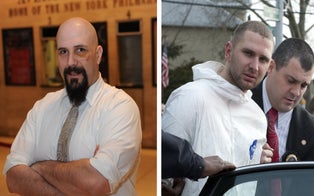Now, more than five decades after the heist that made headlines around the world, what ever happened to Janet Florkiewicz?
When three Florida beach bums burgled the Museum of Natural History in 1964 — in one of the most brazen heists in New York City history — they placed the success of the getaway squarely in the hands of a 19-year-old woman.
But she had no idea.
Now, more than five decades after the heist that made headlines around the world, what ever happened to Janet Florkiewicz?
'Innocent Bystander'
In October 1964, Jack “Murf the Surf” Murphy, Alan Kuhn and Roger Clark — Miami friends in their mid-to-late 20s — drove to New York City to pull off the ultimate caper. Their goal: to rob one of the world’s most-esteemed cultural institutions of rare jewels they would then flip on the black market.
After arriving in New York City, they checked into the Cambridge House Hotel on the Upper West Side and began researching how to rob the J.P. Morgan Collection at the American Museum of Natural History.
But they also found time to live the high life, throwing parties, attending jazz clubs and sightseeing. They also met Florkiewicz, a secretary for a Wall Street insurance firm who’d recently moved from Staten Island to the apartments in the Cambridge House Hotel.
Florkiewicz and Kuhn soon became romantically involved. Florkiewicz accompanied him on numerous dates to the Museum of Natural History, unaware he was there not to admire prehistoric bones and precious gems, but to case the joint.
The research paid off: On the night of Oct. 29, 1964, the men carried out their plan successfully, fleeing with a handful of diamonds and three priceless, one-of-kind gems: the Star of India, the DeLong Star Ruby and the Midnight Star. They celebrated the heist with more partying back at the hotel.
The next morning, Murphy and Kuhn boarded a plane back to Miami with Florkiewicz, while Clark drove their car to Connecticut to visit family. By the time museum staff realized it had been robbed, the three perpetrators had left the city — with Florkiewicz in tow.
Florkiewicz sat in a different section of the plane from the two men and carried a bag given to her by her reported boyfriend. What she didn’t realize was that this small yellow case carried millions of dollars of stolen gems.
“She never was told what was in that case,” said “Vanity Fair” journalist and NYU professor Meryl Gordon. “[They] seated her in a different row, [and] bought different tickets. So, if anything had happened, this young girl would have been the one [authorities] would have gotten.”
Meanwhile, back in New York, news of the heist was spreading.
“It was a huge story that continued to be a huge story,” Gordon said. “Nora Ephron — then the kid reporter — that was her first big story she was sent out on. It was huge front-page headlines.”
Incredibly, Florkiewicz and the two men landed and left the airport without issue. Back at Kuhn’s apartment, they promptly sent her out so they could begin examining the stones.
“When they got down to Florida, they closed the drapes, and they began rolling the jewels on the floor, and just looking at how they were shining in the light, and kind of this amazing, ‘Look at what we got,’” Gordon said.
Meanwhile, later that day, growing concerned, Florkiewicz left a message for her roommate, saying she was being held against her will and urging her friend to contact authorities, Vanity Fair reported. Her roommate did as she was told. Simultaneously, an employee from the New York hotel called cops to say three men from Florida had been spending copious amounts of money there after the heist would have occurred.
Cops checked out the trio’s hotel room, which hadn't been touched, and discovered museum floor plans, books about jewels, scales and sneakers with glass in them. As police surveyed the room, Clark returned from Connecticut and was arrested.
Eventually, Clark gave up his friends and, within a few days of the crime, Kuhn and Murphy were arrested and sent to New York.
Florkiewicz wasn’t arrested in Florida but as soon as she stepped foot in New York City, she was busted, too, held as a material witness.
'Awful Part of Her Life'
The men — out on bail since none of the jewels had yet been recovered — began charming the press and soon returned to Miami.
But, convinced Florkiewicz could give them the information they needed to get convictions, authorities placed her under protective custody as a material witness inside a Manhattan hotel.
In front of the grand jury, she testified she had seen the gems while on the plane but, just one day later, she recanted, with her attorney saying “she made this up” because she was afraid of the police.
“My client says when she got off the plane in New York she was asked at the precinct whether she saw the gems and she said no,” her lawyer, William Power Maloney, told the judge. “The police said that if she wouldn't talk and say she saw the jewels she would go to jail. She told me that it was then that she'd said she had seen the jewels. … The next day she went to the FBI and said she'd lied because the police had threatened her with jail.”
The D.A.’s office said she had to tell the same story, otherwise she would have committed perjury, so she again lied to the grand jury, saying she’d seen the gems, her lawyer said.
“I don't see how this girl can be a witness to anything when she will testify that she lied under oath,” he said.
Florkiewicz's bail was raised from $5,000 to $25,000, as she was deemed a flight risk by the judge and prosecutor. There was also concern for Florkiewicz’s safety as the suspects had been trying to contact her since her arrest according to the judge, who called her “young and without mature judgement.” She continued to be held as a material witness at a Manhattan hotel.
Meanwhile, the three men were free to enjoy their lives until Kuhn and Murphy were arrested for another robbery in Miami in January 1965. Around that time, the two men were also identified as the suspects of an armed robbery of actress Eva Gabor and her husband.
All three men were detained in New York City and the priceless jewels were recovered.
As for Florkiewicz, she was released from protective custody in February 1965 and she was never prosecuted.
In April 1965, the culprits of the Museum of Natural History heist pleaded guilty to burglary and grand larceny. Each received a three-year sentence.
'A Traumatic Experience'
“I would love to find her and apologize, and do anything I can to make this right,” Kuhn told Gordon about Florkiewicz in 2014. “She was an innocent bystander.”
Following the guilty pleas and recovery of all of the jewels, the story died down in the press and Florkiewicz was able to carry on with her life — although it would never be the same.
Family members told Gordon in 2014 that although she lives a happy life, the story continues to haunt her. They said the men used her and treated her unfairly.
“I spent probably a year trying to find Janet, and she really does not want to be found,” Gordon said. “Vanity Fair even hired a private investigator to try and find her. I did talk to family members of hers in Staten Island, and a relative, who basically just said, ‘This was an awful part of her life.’
“She was held in police custody for several months as a material witness. So, that was pretty traumatic for her.”
Attempts to reach Janet Florkiewicz by InsideEdition.com were unsuccessful.
RELATED STORIES





